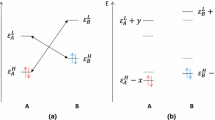Abstract
The usual practice of relating reactivity to a particular MO index does not allow for changes in the relative reactivity of various positions in a conjugated electron donor with the nature of the electrophilic reagent. By regarding the formation of the transition state as a mutual perturbation of the Molecular Orbitals of both reagents, the relative reactivity of various reacting centers is shown to vary with the magnitude of the perturbation. This treatment determines the factors responsible for these changes in reactivity. It outlines the conditions under which the frontier orbitals may determine the course of a reaction and also draws attention to the importance of electrostatic interaction.
Résumé
La pratique habituelle, qui consiste à corréler la réaotivité et un indice particulier de la méthode des orbitales moléculaires, ne tient pas compte des variations relatives de réactivité des différentes positions d'un donneur d'électrons conjugué avec la nature du réactif électrophile. En considérant la formation de l'état de transition comme une perturbation mutuelle des orbitales moléculaires des deux réactifs, la réactivité relative des différents centres réactifs varie avec l'importance de la perturbation. Notre travail détermine les facteurs responsables de ces variations de réactivité. Il définit les conditions ou les orbitales frontiéres peuvent déterminer le cours d'une réaction, et attire l'attention sur l'importance de l'interaction électrostatique.
Zusammenfassung
Im Rahmen der MO-Theorie wird die Reaktivität gewöhnlich nur zu gewissen Indizes in Verbindung gesetzt. Damit ist die Reaktivität an den verschiedenen Zentren eines konjugierten Donators aber unabhängig von der Art des elektrophilen Agens. Wenn man den Übergangszustand als eine wechselseitige Störung der Molekülorbitale beider Agentien auffaßt, ändert sich die relative Reaktivität verschiedener Zentren mit der Größe dieser Störung. Dieses Verfahren bestimmt verschiedene Faktoren, die für den Wechsel in der Reaktivität verantwortlich sind. Es erklärt, unter welchen Bedingungen die „Grenzorbitale“ den Verlauf einer Reaktion bestimmen und verweist auf die Bedeutung von elektrostatischen Wechselwirkungen.
Similar content being viewed by others
References
Brown, R. D.: Quart. Rev. 6, 63 (1952).
- J. Chem. Soc. (London) 1959, 2232.
Coulson, C. A., and H. C. Longuet-Higgins: J. Chem. Soc. (London) 1949, 971.
—: J. Chim. physique 45, 243 (1948); Discussions Faraday Soc. 2, 9 (1947).
—, and H. C. Longuet-Higgins: Proc. Roy. Soc. (London) A 191, 39 (1947); A 195, 188 (1948).
Dewar, M. J. S.: Advances chem. Physics 8, 105 (1965).
—: J. Amer. Chem. Soc. 74, 3341,3345, 3350, 3353, 3355, 3357 (1952).
-, T. Mole, and E. W. T. Warford: J. Chem. Soc. (London) 1956, 3581.
- - J. Chem. Soc. (London) 1957, 342.
—: Advances chem. Physics 8, 110 (1965).
Edwards, J. O.: J. Amer. chem. Soc. 76, 1540 (1954).
Fukui, K., T. Yonezawa, and H. Shingu: J. chem. Physics 20, 722 (1952).
— —, and C. Nagata: J. chem. Physics 27, 1247 (1957); 31, 550 (1959).
— —, and C. Nagata: Bull. chem. Soc. Japan 27, 423 (1954).
Hudson, R. F.: Chimia 16, 173 (1962).
—, and G. Klopman: Tetrah. Letters 12, 1103 (1967).
Klopman, G.: J. Amer. chem. Soc. 86, 4550 (1964); 87, 3300 (1965).
—: J. Amer. chem. Soc. 86, 4550 (1964).
Overlap integrals are those given by: Mulliken, R. S., C. A. Riecke, D. Orloff, and H. Orloff: J. chem. Physics 17, 1248 (1949).
Mulliken, R. S.: J. Amer. chem. Soc. 74, 811 (1952).
—: J. physic. Chem. 56, 801 (1952).
Nagakura, S., and J. Tanaka: Bull. chem. Soc. Japan 32, 734 (1959).
Norman, R. O. C., and G. K. Radda: J. Chem. Soc. (London) 1961, 3610.
Pearson, R. G.: J. Amer. chem. Soc. 85, 3533 (1963).
Pullman, B., and A. Pullman: Les théories électroniques de la chimie organique, p. 615. Masson: Paris 1952.
—: J. chem. Physics 31, 551 (1959).
e.g. Ri, T., and H. Eyring: J. chem. Physics 8, 433 (1940).
Sandorfy, C., and P. Yvan: Bull. Soc. chim. France 17, 131 (1950).
—, C. Vroelant, P. Yvan, O. Chalvet, and R. Daudel: Bull. Soc. chim. France 17, 304 (1950).
Sung, S. S., O. Chalvet, and R. Daudel: J. chem. Physics 31, 553 (1959).
Wheland, G. W., and L. Pauling: J. Amer. chem. Soc. 57, 2086 (1935).
—: J. Amer. chem. Soc. 64, 900 (1942).
Author information
Authors and Affiliations
Rights and permissions
About this article
Cite this article
Klopman, G., Hudson, R.F. Polyelectronic perturbation treatment of chemical reactivity. Theoret. Chim. Acta 8, 165–174 (1967). https://doi.org/10.1007/BF00526373
Received:
Issue Date:
DOI: https://doi.org/10.1007/BF00526373




